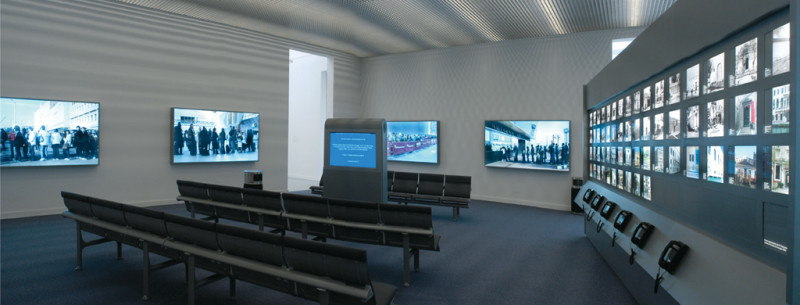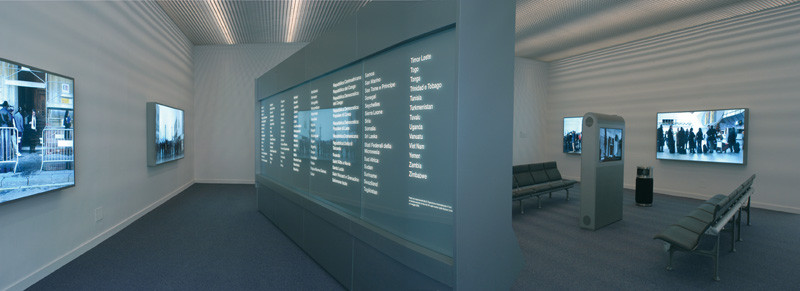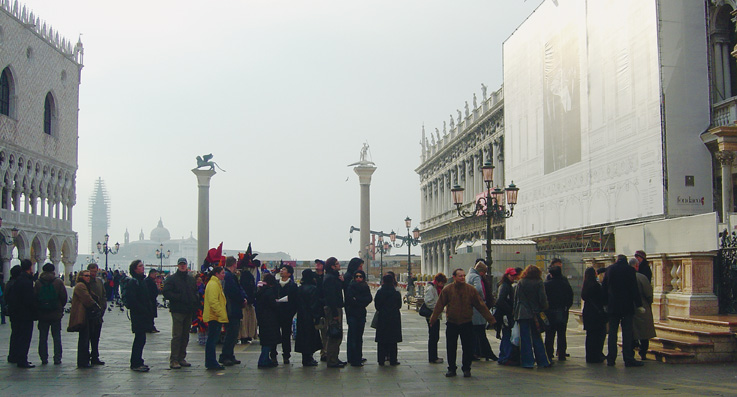[Fall 2007]
Produced on the occasion of Muntadas’s selection as the sole official Spanish representative at the 2005 Venice Biennale, this project explores the mediated nature of the event as a high-profile international cultural manifestation. For this exhibition, Muntadas developed a visual vocabulary that echoes that of commercial tourism and airport marketing.
Moreover, at the 2005 Venice Biennale, at what could be said to be the apogee of his career to date, Muntadas warned viewers off his exhibition with a banner hung over the entrance to the Spanish pavilion declaring “Warning: Perception requires involvement.” This white-on-red reprise of an often re-created 1999 work alerted visitors that, should they enter, they could expect something different from what Peter Schjeldahl has identified as “festival art,” something more along the lines of Santiago Serra’s walled-off entrance to the Spanish pavilion constructed for the 2003 Biennale, something that addressed the premises upon which the art world functions, something that distinguished between inside and outside and between looking and seeing. Duly warned that an investment of time would be required to perceive the exhibition, the decision to enter – or not – took a split second.
Inside the pavilion’s large entrance exhibition hall, Muntadas created an installation highlighting the conjuncture of time (historical as well as contemporaneous) and access. As part of the ensemble, he hung a selection from Stand By (2005), a photographic series that documents people lined up outside a historic site, an exhibition, a concert. He made this longstanding and increasingly widespread phenomenon of spectator culture – the ritual of waiting in line before the event – visible. When shown in the context of an exhibition, as Stand By was in Venice (rather than, say, in print), outside and inside, of course, collapse: the time before and during the exhibition becomes a self-reflexive, combined moment in which the similarities between Muntadas’s exhibition and other cultural events are both heightened and differentiated.
The figures on the monitor placed the Biennale and its art in a network alongside the worlds of commerce, tourism, entertainment, and politics that made it possible.
During
Muntadas’s selection of six images from Stand By, displayed individually in light boxes edged in black and grouped in pairs, simultaneously stood alone as an independent artwork and morphed into brilliantly coloured, glowing, decorative wall art framing the hybrid architectural installation that Muntadas calls On Translation: I Giardini. As a site-specific construction, I Giardini amalgamated elements of an airport lounge, a real-estate agency, and an information centre: three architectural zones in three intersecting spheres – travel, property, and information – in which the underprivileged wait for access or are restricted from entry.
With its coolness, low lighting, generic furnishings, and bench seating, the introductory space of the pavilion was both known and unknown. Muntadas’s environment resembled familiar anonymous waiting areas in commercial and travel centres, but felt and was out of place. It seemed to offer a welcome respite from the relentless Venetian sun, sore feet, and other pressures of seeing so much Biennale art, but soon this trompe-l’oeil art-neutral space became what it was – high art demanding involvement. Once the apparent ante-chamber was perceived as an installation integral to Muntadas’s self-reflexive biennale entry, viewers could decide to spend more time and remain in the dark for further enlightenment or be enticed by the five well-lit gallery spaces visible beyond.
In addition to the Stand By light boxes, Muntadas’s installation presented two other types of light-emitting surfaces with information related to the Biennale. One was a monitor with rolling aphorisms and statistical facts taken from the world at large that for the most part did not appear to be related directly to the Biennale but provided a wider context into which to place it. The monitor was built into a small bunker wall set in front of three rows of seating, resembling the placement of a television in an airport waiting area. Viewers were able to tune in or out the data that appeared on the screen – information about the number of tourists to Venice in the last year, the number of dead and wounded in a Buenos Aires nightclub, the number of hits a day on Google, the number of Colombian soldiers killed in an ambush, and so on. The figures in Stand By removed the singularity of the Biennale by linking it to a network of similar cultural events; the figures on the monitor placed the Biennale and its art in a network alongside the worlds of commerce, tourism, entertainment, and politics that made it possible. Muntadas juxtaposed these two synchronic reference systems with a detailed diachronic dénouement: the history of the Biennale as told through a wall of backlit portraits of the national pavilions in the Giardini.
Unlike previous presentations of the history of the Biennale, which focused on its exhibitions, Muntadas presented the Biennale’s architectural history both as a typology related to world fairs and as an expression of the politics of nationalism and colonialism. On one side of an angled freestanding wall, he arranged same-size archival and current photographs of the façades of the pavilions in rows, similar in structure and glow to arrangements of images of real-estate properties for sale or hotels for rent. Viewers could learn more by picking up the attached phones. Should they walk around the back of the wall, they would encounter a list of the 123 of 191 member nation states of the United Nations that do not have a national pavilion at the Biennale. Again, by making a well-known phenomenon visible, Muntadas pointed out how archaic, escapist, and exclusionary the Biennale remains.
After
Muntadas’s life work has been to demonstrate how experience is translated, filtered, transformed, mediated. Often, he shows us what we know is wrong with a given system, without placing blame or providing solutions. In so doing, he asks that we think again about how we live, what we tolerate, and where our actions lead. On Translation: I Giardini belongs to this grand project.
During the run of the exhibition, Muntadas documented his Giardini environment. Like all installation photographs, his images record what was there at the time but literally flatten the event, removing the physiological, intellectual, and emotional responses that accompanied seeing the work in situ. Muntadas made sure to include people in his shots, but when the photographs are presented out of context, printed in magazines or mounted on the wall, it is hard to conjure up the effect of discovering such a space within the pavilion during a Biennale or the time that it took to experience the work. Muntadas’s catalogue, however, does convey the flavour of his Giardini project. Shaped like a traditional guidebook, tall and narrow, and replete with photographs, essays, and interviews on Muntadas’s art and the history of the Biennale, the catalogue carries forward, as useful, informative, and intriguing for subsequent editions of the Biennale as it was for Muntadas.
At the 2007 Biennale, the Spanish pavilion changed course, presenting a group show of four artists. The title Paradiso Spezzato (Broken Paradise), taken from Ezra Pound, made it clear that the politicized Serra-Muntadas lineage contesting the restrictive, outdated biases of the Biennale had given way to poetics. What remains of Muntadas’s I Giardini intervention are its components. These could be reinstalled in the Spanish pavilion for many biennales to come without losing their timeliness. Such an insistent and repetitive gesture would ask, again and again, that everyone who participated – artists, curators, administrators, collectors, visitors – accept that perception does comes with involvement and make it easier to let go of outmoded systems of representation, cherished institutions, and seemingly important economies; to imagine and implement deep structural change; to relinquish a timeless image of the Biennale; to enter today’s world, leave fantasies that belong in the past behind, and construct a different future.
Through his work, Antoni Muntadas (Barcelona, 1942) addresses social, political, and communications issues, the relationship between public and private space within social frameworks, and the ways that channels of information may be used to censor ideas. He works with photography, video, publications, the Internet, and multimedia installations. His works have been exhibited throughout the world, in events such as the Venice Biennale (1976 and 2005); Documenta Kassel (VI and X Edition); the Whitney Museum Biennial; and the Sao Paulo, Lyon, Taipei, Gwangju and Havana biennales.
Reesa Greenberg is an Ottawa/Montreal art historian who works on the ethics and aesthetics of display. She is interested in questions of nationalism, war, minority cultures, and contemporary art. www.reesagreenberg.net







